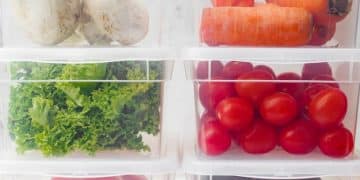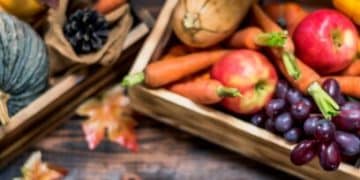Stop Overspending: Ultimate Guide to Meal Planning for Grocery Savings 2025
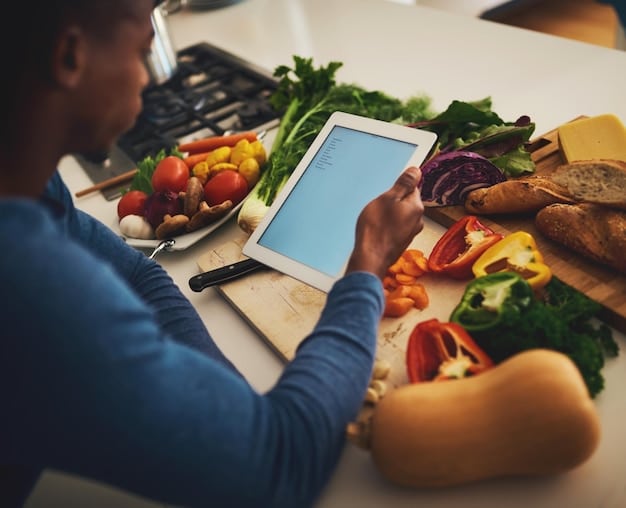
Achieving significant grocery savings in 2025 is highly attainable by implementing strategic meal planning, which streamlines shopping habits, reduces food waste, and optimizes household budgets without sacrificing nutritional value or culinary enjoyment.
In an era where every penny counts, mastering your grocery budget is more crucial than ever. The concept of Stop Overspending: The Ultimate Guide to Meal Planning for Grocery Savings in 2025 isn’t just about cutting costs; it’s about intelligent consumption, reducing waste, and gaining control over one of your household’s largest variable expenses. This guide delves into actionable strategies that empower you to transform your kitchen into a hub of efficiency and savings.
The Foundation: Understanding Your Spending Habits
Before you can effectively stop overspending on groceries, it’s vital to truly understand where your money is currently going. Many people underestimate their weekly food expenditures, often surprised by the cumulative cost of impulse buys, forgotten ingredients, and excessive takeout meals. A comprehensive audit of your current spending habits provides the necessary baseline for identifying areas of unnecessary outlay and setting realistic savings goals for 2025.
This initial assessment isn’t about judgment, but about awareness. It involves looking at bank statements, past grocery receipts, and even tracking spontaneous food purchases. Understanding the “why” behind your spending – whether it’s convenience, lack of planning, or emotional triggers – is the first step toward effective change. Once you have a clear picture, you can begin to craft a meal plan that addresses these specific pain points, ensuring every dollar spent on groceries serves a purpose.
Tracking Your Current Grocery Outgoings
To accurately assess your spending, consider using various methods. Digital tools offer convenience, while a manual approach can provide a more tactile understanding of your habits.
- Digital Expense Trackers: Utilize budgeting apps or spreadsheet software to log all food-related purchases. Many banking apps now categorize spending automatically, simplifying this process.
- Receipt Hoarding: Collect every grocery and food-related receipt for a month. At the end of the period, categorize and sum up the spending. This can reveal patterns you didn’t perceive.
- Meal Delivery and Takeout Audit: Don’t forget to account for restaurant meals, coffee runs, and meal kit subscriptions. These can significantly impact your overall food budget.
By diligently tracking your expenses, you’ll uncover hidden spending leaks and gain clarity on your true consumption patterns. This insight is invaluable as you transition into proactive meal planning, allowing you to tailor your strategies to your unique household needs and financial objectives.
Crafting Your Strategic Meal Plan for 2025
A well-devised meal plan is the cornerstone of grocery savings. It transforms abstract saving goals into a concrete, week-by-week strategy. For 2025, consider integrating flexibility and seasonality into your planning, making it sustainable and enjoyable rather than a restrictive chore. The goal is to create a plan that aligns with your lifestyle, dietary preferences, and budget, ensuring you only buy what you need and use what you buy.
Start by dedicating a specific time each week, perhaps a Sunday afternoon, to plan your meals. This ritual allows you to review your pantry, take stock of expiring ingredients, and consider upcoming events that might influence your eating. A strategic meal plan takes into account not just dinner, but also breakfasts, lunches, and snacks, effectively eliminating the need for impromptu, costly food purchases.
Key Elements of an Effective Meal Plan
Building a meal plan requires thought and foresight. Incorporate these elements to maximize its effectiveness:
- Inventory First: Always begin by checking your current pantry, fridge, and freezer. Plan meals around ingredients you already have to minimize waste and reduce your shopping list.
- Seasonality and Sales: Incorporate seasonal produce and items that are on sale. These are often fresher, more flavorful, and significantly cheaper.
- Theme Nights: Simple themes like “Meatless Monday,” “Taco Tuesday,” or “Pasta Wednesday” can simplify decision-making and add variety without requiring extensive thought.
- Batch Cooking & Leftovers: Plan for meals that can be cooked in larger quantities, providing lunches for the week or an easy dinner later. This saves time and money.
- Flexibility: While planning is crucial, don’t be afraid to adjust. Life happens, and being able to swap a meal or shift one to a different day prevents food waste.
By proactively structuring your meals, you take control of your food consumption, reducing last-minute decisions that often lead to overspending. This strategic approach ensures every ingredient you purchase serves a purpose within your culinary week.
Smart Shopping Strategies: Beyond the List
Once your meal plan is meticulously crafted, the next step is to execute it through smart shopping. This goes beyond simply sticking to your list; it involves understanding supermarket psychology, utilizing digital tools, and making informed decisions while in the aisles. In 2025, leverage technology and time-tested wisdom to optimize every grocery run, transforming a potential money pit into a financial win.
Before even stepping into the store, consider factors like the time of day, the specific store’s layout, and how you’ll transport your groceries. Avoiding shopping when hungry, for instance, is a classic tip that remains incredibly effective. The objective is to make your grocery trip a mission-driven exercise, devoid of distractions and impulse temptations. Every item in your cart should directly correspond to your meal plan.
Advanced Grocery Shopping Techniques
To truly master the art of grocery savings, integrate these advanced techniques:
- Unit Price Comparison: Always check the unit price (price per ounce, per pound, etc.) rather than just the package price. Larger packages aren’t always a better deal.
- Strategic Store Visits: Consider visiting multiple stores for specific deals, but only if the gas or time cost doesn’t outweigh the savings. Some items might be cheaper at a discount store, while others are best at a larger supermarket.
- Online vs. In-Store: Explore online grocery delivery or pickup services. This can help you avoid impulse purchases, but be mindful of delivery fees and minimum order requirements.
- Couponing and Loyalty Programs: Actively use digital and paper coupons for items you already plan to buy. Join loyalty programs for exclusive discounts and personalized offers.
- Limit Shopping Trips: Reduce the frequency of your grocery visits. More trips often mean more opportunities for impulse buys. A well-planned weekly shop typically suffices.
By merging your solid meal plan with these astute shopping strategies, you ensure that your efforts in planning translate directly into tangible savings at the checkout, allowing you to stop overspending effectively.
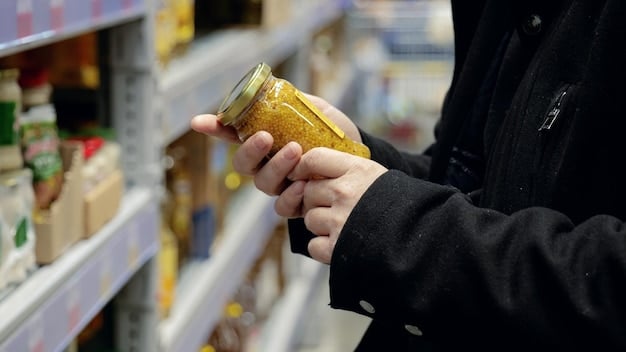
Minimizing Food Waste: The Unsung Hero of Savings
Food waste is not merely an environmental concern; it’s a direct drain on your budget. Reducing what ends up in the trash or compost bin is arguably one of the most effective ways to realize significant grocery savings in 2025. This involves understanding proper food storage, creative cooking with scraps, and making the most of every ingredient purchased. The less food you throw away, the less money you’re effectively throwing away.
The average household wastes a substantial amount of food annually, often due to improper storage, misunderstanding “best by” dates, or simply forgetting what’s lurking in the back of the fridge. Implementing practices that extend the life of your groceries and ensure everything gets used transforms potential waste into tangible savings, contributing directly to your goal to stop overspending.
Practical Strategies to Combat Food Waste
Adopt these habits to make every ingredient count:
- Proper Storage: Learn the best ways to store different types of produce, dairy, and meats. For example, storing herbs in water, or keeping avocados in the fridge once ripe, can extend their freshness.
- First In, First Out (FIFO): When putting away groceries, move older items to the front of your pantry or fridge so they are used first.
- Understand Date Labels: “Sell by,” “best by,” and “use by” dates have different meanings. “Use by” is critical for safety, but “best by” often indicates peak quality, not food spoilage. Trust your senses more for many items.
- Leftover Reinvention: Don’t just reheat leftovers; transform them. Cooked vegetables can become a frittata filling, roasted chicken can be shredded for tacos, and rice can be used for fried rice.
- Freezing for Later: Freeze excess ingredients, pre-portioned meals, or bread to prevent spoilage. From vegetable scraps for broth to overripe fruit for smoothies, the freezer is your friend.
By integrating these waste-reduction techniques into your daily routine, you not only save money but also contribute to a more sustainable and efficient household, making your grocery budget stretch further than ever before.
Budget-Friendly Recipes & Smart Substitutions
The true art of meal planning for grocery savings lies in the ability to create delicious, nutritious meals using cost-effective ingredients and a knack for clever substitutions. In 2025, focus on recipes that are inherently budget-friendly and learn how to adapt existing recipes to fit your wallet without sacrificing flavor or nutritional value. This approach ensures your path to stop overspending is also a path to culinary creativity.
Embracing budget-friendly cooking doesn’t mean eating bland or repetitive meals. It encourages exploring versatile ingredients like legumes, seasonal vegetables, and less expensive cuts of meat. Moreover, mastering the art of substitution means you’re less likely to “panic-buy” an expensive ingredient when faced with an empty pantry, fostering resourcefulness in the kitchen.
Maximizing Value in Your Meal Prep
Consider these strategies when planning your meals and preparing your dishes:
- Embrace Pulses: Lentils, beans, and chickpeas are incredibly versatile, packed with protein and fiber, and significantly cheaper than meat. They can be the star of a meal or extend meat dishes.
- Versatile Vegetables: Root vegetables like potatoes, carrots, and onions, along with robust greens like cabbage and kale, are not only inexpensive but also have a long shelf life and can be used in countless dishes.
- Smart Meat Choices: Opt for less expensive cuts of meat, like chicken thighs instead of breasts, or ground meat instead of steaks. Learn how to tenderize and flavor them using slow cooking methods or marinades.
- DIY Staples: Consider making staples like bread, stock, sauces, or yogurt from scratch. While requiring time, it often results in significant savings and healthier options.
- Ingredient Swaps: Learn common substitutions: plain yogurt for sour cream, plant-based milk for dairy, herbs for spices, etc. This flexibility means you don’t need to buy a specific ingredient for just one recipe.
By consciously selecting ingredients and adapting recipes, you can consistently enjoy satisfying meals that are both kind to your palate and your budget. This empowers you to stay within your spending limits while still exploring a world of culinary possibilities.
Leveraging Technology for Modern Grocery Savings
In 2025, technology offers an unprecedented array of tools to assist with meal planning and grocery savings. From smart shopping lists to price comparison apps, digital solutions can streamline your efforts to stop overspending and make the entire process more efficient and enjoyable. Embracing these innovations can significantly amplify your savings while reducing the time and mental effort involved in managing your food budget.
Apps and online platforms extend beyond basic shopping lists, providing insights into optimal purchasing times, personalized deals, and even tracking consumption habits. Integrating these tools into your routine means less guesswork and more data-driven decisions, turning your smartphone or tablet into a powerful ally in the fight against grocery overspending.
Essential Apps and Digital Strategies
Explore these technological aids to enhance your savings:
- Meal Planning Apps: Many apps allow you to plan meals, create grocery lists, and even suggest recipes based on ingredients you have or items on sale. Examples include Mealime, Paprika, or Recipe Keeper.
- Cashback and Reward Apps: Apps like Ibotta, Fetch Rewards, or Checkout 51 offer cash back on specific grocery purchases or simply by scanning your receipts. Always check terms to ensure the items align with your plan.
- Price Comparison Tools: Websites or apps that compare prices across different supermarkets can save you time and money, helping you identify the best deals on your staples.
- Digital Couponing Platforms: Most major grocery chains offer digital coupons through their apps or websites. Load these onto your loyalty card before shopping to automatically apply discounts.
- Smart Inventory Management: Some apps help you track what you have in your pantry and fridge, sending alerts before items expire and suggesting recipes to use them up.
By thoughtfully integrating these technological resources, you can automate much of the “heavy lifting” involved in meal planning and grocery shopping, freeing up time while consistently achieving your financial goals and preventing unnecessary expenditure.
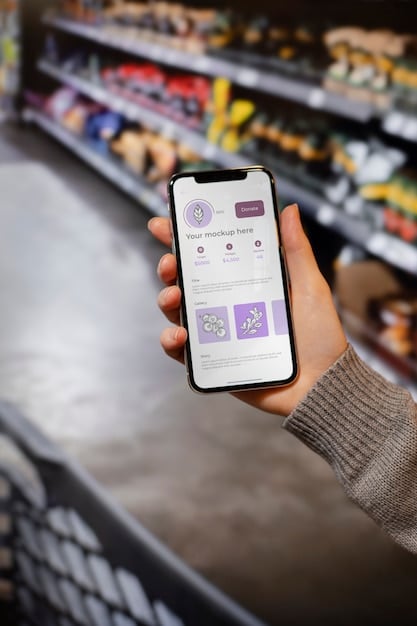
Seasonal and Bulk Buying: Strategic Stocking
Strategic stocking, particularly through seasonal and bulk buying, is a time-honored method to achieve substantial grocery savings. When produce is in season, it’s often at its cheapest and highest quality. Similarly, purchasing non-perishable goods and freezable items in bulk can lead to considerable cost reductions over time. This approach requires foresight, storage space, and an understanding of your consumption patterns, but the dividends in savings are well worth the effort to stop overspending.
The concept is simple: buy low, store smart. When berries are abundant and inexpensive in summer, consider buying extra to freeze for smoothies and pies in winter. When pantry staples like rice, pasta, or canned goods are on a deep discount, buying a larger quantity ensures you have a supply without paying full price later. This proactive stocking reduces your average cost per unit and protects you from future price fluctuations.
Mastering Seasonal and Bulk Purchases
To optimize your strategic stocking, consider the following:
- Know Your Seasons: Familiarize yourself with the growing seasons for fruits and vegetables in your region. Farmers’ markets are excellent places to find seasonal deals.
- Storage Solutions: Ensure you have adequate and appropriate storage for bulk items. This might mean investing in airtight containers, extra freezer space, or dedicated pantry shelving.
- Calculate Your Needs: Don’t buy more than you’ll realistically use before it spoils or expires. A bulk deal isn’t a saving if half of it goes to waste.
- Price Per Unit Again: Always calculate the unit price when buying in bulk. Sometimes, smaller packages on sale can still be a better deal than a large bulk purchase at its regular price.
- Costco/Sam’s Club Strategy: If considering a warehouse club membership, analyze if the annual fee and bulk-buying opportunities genuinely lead to savings for your specific consumption habits. Focus on items you consistently use and can store.
By becoming a savvy seasonal and bulk shopper, you proactively manage your food supply, ensuring your pantry and freezer are always well-stocked with affordable, high-quality ingredients. This foresight minimizes last-minute, expensive purchases and contributes significantly to your overall grocery savings strategy.
| Key Point | Brief Description |
|---|---|
| 📊 Spend Tracking | Understand current grocery habits to identify overspending areas. |
| 🗓️ Meal Planning | Create weekly plans based on inventory, sales, and flexibility. |
| 🛒 Smart Shopping | Utilize lists, unit prices, and digital tools to reduce impulse buys. |
| 🗑️ Waste Reduction | Implement proper storage and creative cooking to maximize food use. |
Frequently Asked Questions About Grocery Savings
▼
Meal planning saves money by minimizing impulse purchases at the store, reducing food waste from forgotten or unused ingredients, and allowing you to take advantage of sales and seasonal produce. By knowing exactly what you need, you avoid buying unnecessary items and ensure every grocery dollar is spent efficiently towards planned meals, eliminating costly last-minute decisions.
▼
For 2025, top apps include those for meal planning (e.g., Mealime, Yummly), digital couponing (supermarket-specific apps), cashback rewards (e.g., Ibotta, Fetch Rewards), and price comparison (e.g., Flipp). These tools collectively help create smart lists, find deals, and get money back on purchases, significantly streamlining the savings process and helping you stop overspending.
▼
Not always. While often cheaper per unit, bulk buying is only cost-effective if you can completely consume the product before it spoils or expires. Always compare the unit price (e.g., per ounce, per pound) for both bulk and smaller packages. Consider your storage capacity and actual consumption rate before committing to large quantities, ensuring true savings.
▼
Reducing food waste involves proper storage techniques (e.g., knowing where to store fruits/vegetables), understanding “best by” vs. “use by” dates, and creatively using leftovers. Prioritize using older ingredients first, freeze excess produce or cooked meals, and transform scraps into stocks or other dishes. These practices ensure you get maximum value from every item.
▼
Seasonal eating significantly reduces costs because produce is more abundant, requires less transportation, and is at its peak quality. Buying in-season fruits and vegetables often means paying less than for out-of-season items that have traveled far or been grown in hothouses. This also encourages diet variety and supports local agriculture, maximizing flavor and freshness while saving you money.
Conclusion
Implementing a comprehensive strategy to “Stop Overspending: The Ultimate Guide to Meal Planning for Grocery Savings in 2025” is more than just a financial endeavor; it’s a lifestyle shift. By understanding your spending, meticulously planning your meals, shopping smarter, minimizing waste, and intelligently stocking your pantry, you gain profound control over your grocery budget. These concerted efforts not only lead to substantial savings but also foster healthier eating habits, reduce environmental impact, and bring a sense of calm and efficiency to your daily routine. Take these steps, adapt them to your unique needs, and watch your grocery savings grow in the coming year, providing a lasting impact on your household finances and overall well-being.

